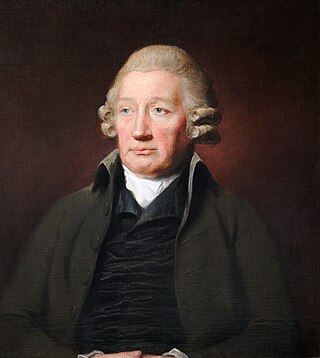
John "Iron-Mad" Wilkinson was an English industrialist who pioneered the manufacture of cast iron and the use of cast-iron goods during the Industrial Revolution. He was the inventor of a precision boring machine that could bore cast iron cylinders, such as cannon barrels and piston cylinders used in the steam engines of James Watt. His boring machine has been called the first machine tool. He also developed a blowing device for blast furnaces that allowed higher temperatures, increasing their efficiency, and helped sponsor the first iron bridge in Coalbrookdale. He is notable for his method of cannon boring, his techniques at casting iron and his work with the government of France to establish a cannon foundry.
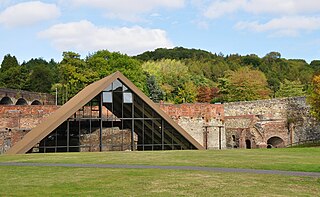
Coalbrookdale is a village in the Ironbridge Gorge and the Telford and Wrekin borough of Shropshire, England, containing a settlement of great significance in the history of iron ore smelting. It lies within the civil parish called the Gorge.

An ironworks or iron works is an industrial plant where iron is smelted and where heavy iron and steel products are made. The term is both singular and plural, i.e. the singular of ironworks is ironworks.
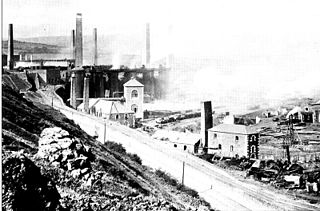
The Cyfarthfa Ironworks were major 18th- and 19th-century ironworks in Cyfarthfa, on the north-western edge of Merthyr Tydfil, in South West Wales.

The Dowlais Ironworks was a major ironworks and steelworks located at Dowlais near Merthyr Tydfil, in Wales. Founded in the 18th century, it operated until the end of the 20th, at one time in the 19th century being the largest steel producer in the UK. Dowlais Ironworks were the first business to license the Bessemer process, using it to produce steel in 1865. Dowlais Ironworks was one of the four principal ironworks in Merthyr. The other three were Cyfarthfa, Plymouth, and Penydarren Ironworks. In 1936 Dowlais played a part in the events leading to the abdication crisis of Edward VIII, when the King visited the steelworks and was reported as saying that "these works brought these men here. Something must be done to get them back to work", a statement which was seen as political interference. The steelworks closed in 1987.

Horsehay is a suburban village on the western outskirts of Dawley, which, along with several other towns and villages, now forms part of the new town of Telford in Shropshire, England. Horsehay lies in the Dawley Hamlets parish, and on the northern edge of the Ironbridge Gorge area.
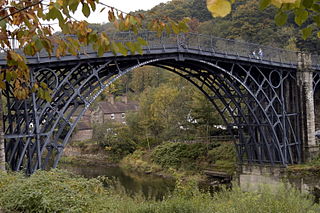
An ironmaster is the manager, and usually owner, of a forge or blast furnace for the processing of iron. It is a term mainly associated with the period of the Industrial Revolution, especially in Great Britain.

Bersham Ironworks were large ironworks at Bersham, near Wrexham, Wales. They are most famous for being the original working site of John Wilkinson. They were also the first site in the world to use a new way of boring holes in cannon and steam engine cylinders.

Brymbo is a village and community in Wrexham County Borough, Wales. It lies in the hilly country to the west of Wrexham city, largely surrounded by farmland.
The Hook Norton ironstone quarries (Brymbo) were ironstone quarries near Hook Norton in Oxfordshire, England. The quarries were in operation from 1899 to 1946 supplying ironstone to the Brymbo Steelworks in Wrexham and were served by the Brymbo Ironworks Railway, an extensive, 2 ft (610 mm) narrow gauge industrial railway.
Isaac Wilkinson was an English industrialist, one of the founders of the iron industry and pioneer of the Industrial Revolution. However, his business ethics were precarious and his commercial affairs frequently chaotic. He became much addicted to litigation.

Henry Robertson was a Scottish mining engineer and prolific railway builder, industrialist and Liberal Party politician. He was head of Brymbo Steelworks, Wrexham. He was co-founder of Beyer-Peacock, with Charles Beyer, and Richard Peacock. His son Sir Henry Beyer Robertson was knighted by Queen Victoria for the achievements of his father.

Broughton is a community in Wrexham County Borough, Wales. It has an area of 469 hectares and had a population of 6,498 in the 2001 census, increasing to 7,454 at the 2011 Census. The area is dominated by the Moss Valley, which was known for its coal mining. Today it is operated as a country park, and there is a golf course of the same name in the vicinity.
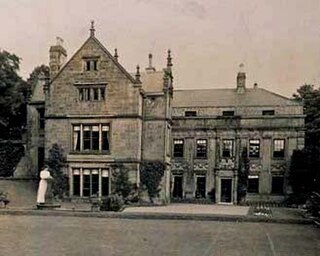
Brymbo Hall, one of Britain's lost houses, was a manor house located near Brymbo outside the town of Wrexham, North Wales. The house, reputed to have been partly built to the designs of Inigo Jones, was noted as the residence of 18th-century industrialist and ironmaster John "Iron-Mad" Wilkinson.

Darkhill Ironworks, and the neighbouring Titanic Steelworks, are internationally important industrial remains associated with the development of the iron and steel industries in the 19th century. Both are scheduled monuments. They are located on the edge of a small hamlet called Gorsty Knoll, just to the west of Parkend, in the Forest of Dean, Gloucestershire, England. Historically, Darkhill was sometimes written Dark Hill.
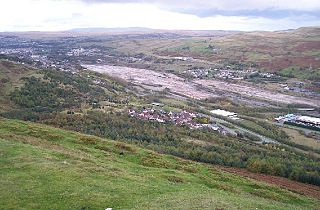
Ebbw Vale Steelworks was an integrated steel mill located in Ebbw Vale, South Wales. Developed from 1790, by the late 1930s it had become the largest steel mill in Europe. It was nationalised after World War II. As the steel industry changed to bulk handling, iron and steel making was ceased in the 1970s, and the site was redeveloped as a specialised tinplate works. It was closed by Corus in 2002, but is being redeveloped in a joint partnership between Blaenau Gwent Council and the Welsh Government.

The Iron and Steel Industry in Scunthorpe was established in the mid 19th century, following the discovery and exploitation of middle Lias ironstone east of Scunthorpe, Lincolnshire, England.
Sir Henry Beyer Robertson was a British industrialist. He was the son of Henry Robertson, of Palé Hall, Llandderfel.

The Lithgow Blast Furnace is a heritage-listed former blast furnace and now park and visitor attraction at Inch Street, Lithgow, City of Lithgow, New South Wales, Australia. It was built from 1906 to 1907 by William Sandford Limited. It is also known as Eskbank Ironworks Blast Furnace site; Industrial Archaeological Site. The property is owned by Lithgow City Council. It was added to the New South Wales State Heritage Register on 2 April 1999.

Plas Madoc is a housing estate and former electoral ward near Acrefair, in the Cefn community in Wrexham County Borough, Wales. It is located seven miles to the south-west of Wrexham, and contains The Land adventure playground, and a community-run leisure centre with a swimming pool. The area is one of the most deprived areas in Wales, and the fourth most deprived LSOA in Wrexham County Borough.






















